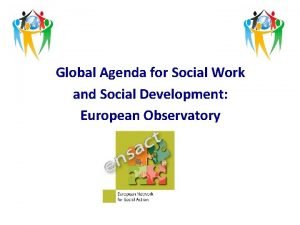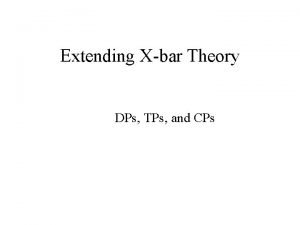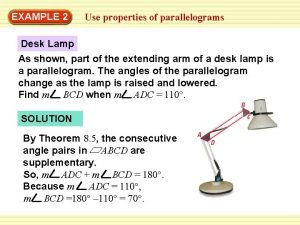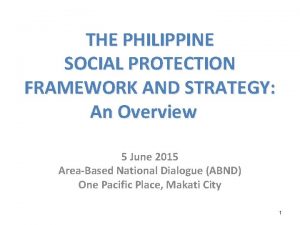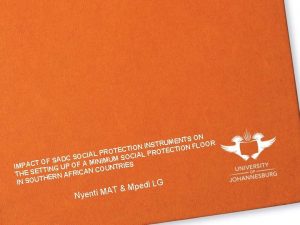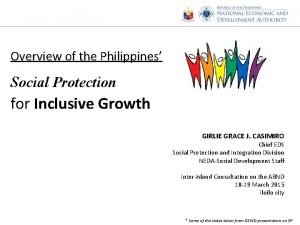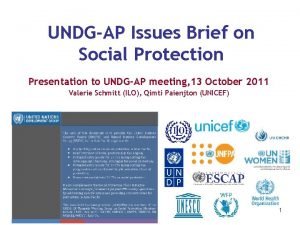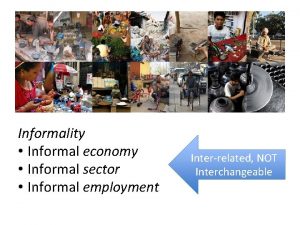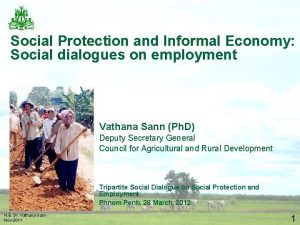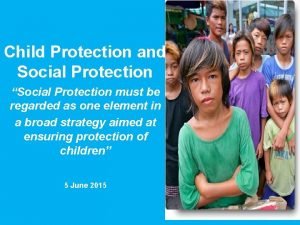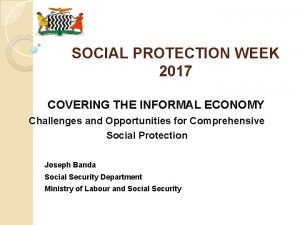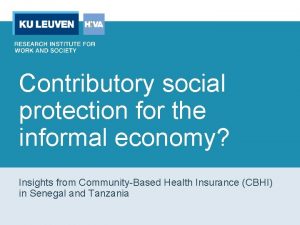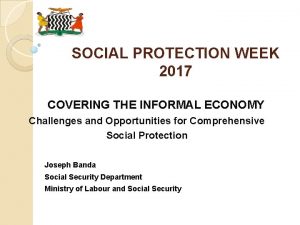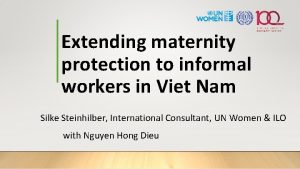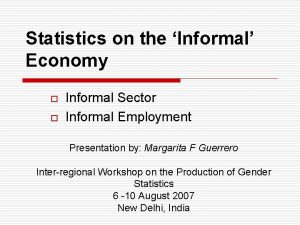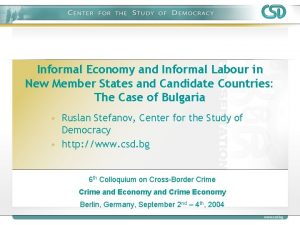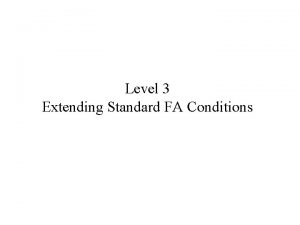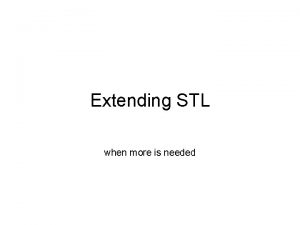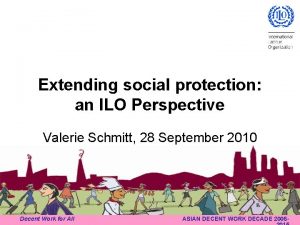Extending Social Protection to the informal economy Agenda



























- Slides: 27

Extending Social Protection to the informal economy

Agenda • What is social protection? • The social protection floor, an opportunity for the informal economy • What is important to know about social protection…

Part 1 The right to social security

Social security as a human right Article 22 Universal declaration of Human Rights: Social security is for all, not only a luxurious product for developed countries or those in formal employment

ILO’s standards for implementing the right to SS C. 102 Social Security (Minimum Standards) Convention, 1952 R 67 Income Security Recommendation, 1944 R 69 Medical Care Recommendation, 1944 C 19 Equality of Treatment (Working Injury) Convention, 1925 C 118 Equality of Treatment (Social Security) Convention, 1962 C 157 Maintenance of Social Security Rights Convention, 1982 C 121 Employment Injury Benefits Convention, 1964 C 128 Invalidity, Old-Age and Survivors' Benefits Convention, 1967 C 130 Medical Care and Sickness Benefits Convention, 1969 C 168 Employment Promotion and Protection against Unemployment Convention, 1988 C 183 Maternity Protection Convention, 2000 R. 202 Recommendation on Social Protection Floors, 2012 5

What is social security? • People face contingencies during their life cycle, which have financial consequences Maternity Sickness / ill health Unemployment Families with children Invalidity Work injury Death of the breadwinner Medical care Old age Life cycle • Social security protects against the economic and social distress caused by such contingencies • Especially for informal economy workers (more vulnerable)

What is social security? THE PROTECTION PROVIDED BY SOCIETY to ALL MEMBERS OF THE SOCIETY To compensate for the loss of income & covers health care expenditures FINANCIAL SUPPORT To facilitate access to social services and fulfill basic needs ACCESS TO SERVICES SOCIAL TRANSFERS

Typology of social transfers Social transfers Contributory Compulsory Social Insurance Non contributory Voluntary Targeted Non-Targeted Extension of social insurance to informal sector Micro-Insurance Targeted social assistance Universal schemes http: //www. social-protection. org/gimi/gess/Show. Theme. do? tid=11&ctx=0

Part 2 The social protection floor, an opportunity to extend social protection to informal economy

Extending social security to all • For a long time, SS was contributory and mainly adapted to the formal sector Level of protection • Assumption that these schemes would progressively extend their coverage with the shrinking of the informal sector • This did not happen…. ? ? ? Poor Rest of informal sector Population Formal sector

Current situation in most developing countries, including Asia • New initiatives emerged: voluntary extension, social welfare for targeted groups • Schemes often scattered, uncoordinated and insufficiently funded Level of protection Social insurance Poor Rest of informal sector Population Formal sector

Current situation in most developing countries, including Asia • As a result, the major part of the population, those in informal economy, is however yet left without adequate protection Poor Rest of informal sector Population Level of protection Formal sector

Achieving the right to social security • All residents should enjoy at least a minimum level of social security • Countries should establish SPFs as a fundamental element of their social security systems Level of protection Social Protection Floor Poor Rest of informal sector Population Formal sector

The social protection floor • Based on this floor, extend social security to provide progressively higher levels of SP benefits to more people Level of protection Social insurance Social Protection Floor Poor Rest of informal sector Population Formal sector

The SPF endorsed globally • R 202 was endorsed by the 185 member states of ILO in June 2012 with 456 ‘yes’ votes and 1 ‘not present’ • R 202 serves as a guidance to member states to establish or maintain nationally defined SPFs http: //www. ilo. org/wcmsp 5/groups/public/---ed_norm/--relconf/documents/meetingdocument/wcms_183326. pdf

The SPF: an amazing opportunity A set of guarantees All residents have access to essential health care All children enjoy income security through transfers in cash or kind access to nutrition, education and care All those in active age groups who cannot earn sufficient income enjoy a basic income security (particularly in case of sickness, unemployment, maternity, disability) All residents in old age have income security through pensions or transfers in kind

What is SPF? Social Protection Floors • Nationally defined SPFs • No ‘one size fits all’ approach : each country defines the levels of benefits that it can/is willing to provide • Each country also decides how to do it – through universal schemes, targeted social assistance, social insurance, a combination…

What is SPF? An investment in human capital • The SPF provides social protection to those in nonformal employment relationships • The SPF promotes employability (employment support and vocational training) • People become active contributors to the economy

Part 3 Social Protection, what is important to know… Fundamental principles

Social Protection can only be successful if … … it builds on: • Social solidarity • Equity and universality • State’s responsibility • Social dialogue • Strategies for enhancing human resource and decent work opportunities

Social solidarity • Principles of social insurance and collective financing • Solidarity among generations, sex, sectors of the economy, type of contracts, … Equity and universality • Equal access to social protection benefits and services: rural/urban, nationals/non-nationals • Progressive extension towards universal coverage (could be with different financing methods)

State’s responsibility Effective social dialogue • Effective coordination and • At all stage: design, policy consistency implementation, monitoring and evaluation • Adequacy of benefits • Tripartite board of social • Good governance security funds • Quality and delivery of • Extending coverage among services informal and rural workers • Ultimate guarantor of the funds

Opportunities • Enhancing capabilities (children’ development, education, vocational training) • Creating opportunities for productive, sustainable and decent employment • Employment covered by social security • Promoting rural development and food security • Recognizing the contribution of older persons to the society and community

Part 4 Challenges to extend social protection to informal economy and elements of response

Persistent informal economy and vulnerable employment • Social insurance (contributory schemes), limited coverage (old-age pensioners covered: from 0 to 28% contributors) • Social protection for vulnerable groups still insufficient (informal, rural and own-account workers) (almost 60% of working population in SE Asia)

Characteristics of the informal economy Irregular incomes Hazardous work and hard working conditions Vulnerability to economic and natural disaster shocks Low access to training and programmes for enhancing capacities • Women tend to be more represented in IE • No or very limited access to social protection (voluntary extension of social insurance unsatisfactory) • Low access to credit • •

Innovative measures for informal economy Innovative measures with close link between social protection and employment promotion • Investment in education, nutrition and health= investment in the future • Adapted social security programmes (mandatory/voluntary, contributory/subsidized/tax funded) • Apprenticeships and vocational training programmes • Public employment programme
 Athens vs sparta differences
Athens vs sparta differences Global agenda for social work and social development
Global agenda for social work and social development Agenda sistemica y agenda institucional
Agenda sistemica y agenda institucional Extending x-bar theory to functional categories
Extending x-bar theory to functional categories Emerging proficient extending
Emerging proficient extending Chapter 12 extending surface area and volume
Chapter 12 extending surface area and volume Extending oblivious transfers efficiently
Extending oblivious transfers efficiently Chapter 7 extending mendelian genetics
Chapter 7 extending mendelian genetics Double bond extending conjugation
Double bond extending conjugation Double bond extending conjugation
Double bond extending conjugation Extending mendelian genetics answer key
Extending mendelian genetics answer key Chapter 7 extending mendelian genetics vocabulary practice
Chapter 7 extending mendelian genetics vocabulary practice A high point of land extending into water
A high point of land extending into water Problem 8-3 extending amounts across the work sheet
Problem 8-3 extending amounts across the work sheet Very large land mass
Very large land mass X bar theory in syntax exercises
X bar theory in syntax exercises Grassland landforms
Grassland landforms Dps tps
Dps tps Gmod lighting
Gmod lighting Blood type dominant recessive
Blood type dominant recessive Chapter 7 extending mendelian genetics vocabulary practice
Chapter 7 extending mendelian genetics vocabulary practice Lenguaje inculto informal ejemplos
Lenguaje inculto informal ejemplos Social thinking adalah
Social thinking adalah Social thinking social influence social relations
Social thinking social influence social relations Social protection operational framework philippines
Social protection operational framework philippines Social protection instruments
Social protection instruments Social protection operational framework philippines
Social protection operational framework philippines Social protection
Social protection

